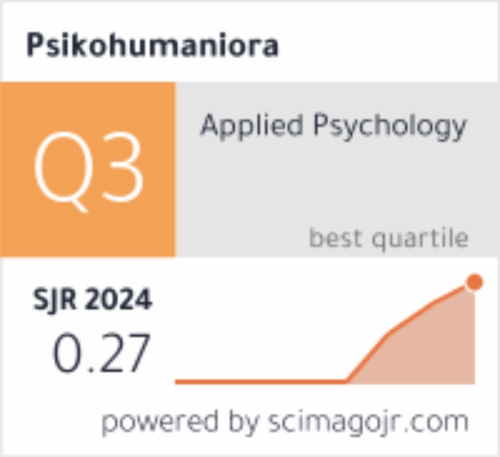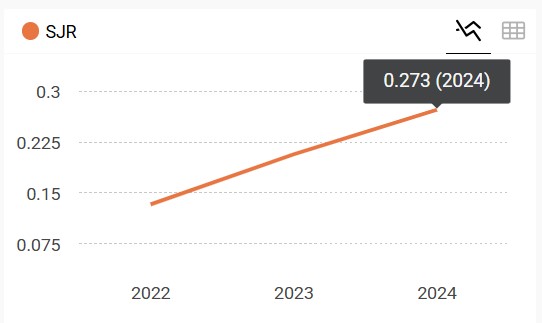Arabic validation of the Three-dimensional Meaning in Life (3DM) Scale: A bifactor model approach
DOI:
https://doi.org/10.21580/pjpp.v9i2.22488Keywords:
3DL scale, meaning in life, psychometric properties, well-beingAbstract
Recent research provides support for the tripartite framework of meaning in life (MIL). The Three Dimensional Meaning in Life (3DM) Scale is a self-report instrument based on the tripartite framework including coherence, purpose, and significance. The present research tested the psychometric properties of the 3DM with Arabic-speaking adults. This cross-sectional study recruited a total of 516 (428 female) participants in the study through online (e.g., social media) and offline (e.g., contacting academicians at different universities in Egypt) data collection. The confirmatory factor analysis replicated the original three-factor solution to the 3DM. The factor loadings of the three-factor model from .61 to .92. The 3DM subscales had good internal consistency scores ranging from .78 to .85. The bifactor model of the Arabic 3DM did not evidence the unidimensional measurement of the 3DM. The findings demonstrate that the Arabic 3DM is a valid and reliable measure. Future research should examine different types of validity and temporal stability of the 3DM, cultural dimensions on MiL, and similarities and distinctions between the tripartite frameworks across diverse populations among Arabic-speaking people.
Downloads
References
Almeida, M., Ramos, C., Maciel, L., Basto-Pereira, M., & Leal, I. (2022). Meaning in life, meaning-making and posttraumatic growth in cancer patients: Systematic review and meta-analysis. Frontiers in Psychology, 13, 995981. https://doi.org/10.3389/fpsyg.2022.995981
Beyer, S. L. (2023). Validation of a German-translated version of the three-dimensional meaning in life scale (Bachelor’s thesis, University of Twente).
Boreham, I. D., & Schutte, N. S. (2023). The relationship between purpose in life and depression and anxiety: A meta‐analysis. Journal of Clinical Psychology, 79(12), 2736-2767. https://doi.org/10.1002/jclp.23576
Costin, V., & Vignoles, V. L. (2020). Meaning is about mattering: Evaluating coherence, purpose, and existential mattering as precursors of meaning in life judgments. Journal of Personality and Social Psychology, 118(4), 864–884. https://doi.org/10.1037/pspp0000225
Deci, E. L., & Ryan, R. M. (2000). The" what" and" why" of goal pursuits: Human needs and the self-determination of behavior. Psychological Inquiry, 11(4), 227-268. https://doi.org/10.1207/S15327965PLI1104_01
Dueber, D. M. (2017). Bifactor indices calculator: A Microsoft Excel-based tool to calculate various indices relevant to bifactor CFA models. https://doi.org/10.13023/edp.tool. 01
Frankl, V. E. (1985). Man’s Search for Meaning. Washington Square Press.
George, L. S., & Park, C. L. (2016). Meaning in life as comprehension, purpose, and mattering: Toward integration and new research questions. Review of General Psychology, 20(3), 205-220. https://doi.org/10.1037/gpr0000077
George, L. S., & Park, C. L. (2017). The multidimensional existential meaning scale: A tripartite approach to measuring meaning in life. The Journal of Positive Psychology, 12(6), 613-627. https://doi.org/10.1080/17439760.2016.1209546
Gerymski, R., & Krok, D. (2020). A Polish adaptation of the Multidimensional Existential Meaning Scale: Internal structure, reliability, and validity. Roczniki Psychologiczne, 23(2), 173190. http://doi.org/10.18290/rpsych20232-4
Gorsuch, R. L. (1983). Factor analysis (2nd ed.). Erlbaum.
Graci, M. E., & Fivush, R. (2017). Narrative meaning-making, attachment, and psychological growth and stress. Journal of Social and Personal Relationships, 34(4), 486-509. https://doi.org/10.1177/0265407516644066
Hancock, G. R., & Mueller, R. O. (2001). Rethinking construct reliability within latent variable systems. In R. Cudeck, S. du Toit, & D. Sorbom (Eds), Structural equation modeling: Present and future—A Festschrift in honor of Karl Joreskog (pp. 195–216). Scientific Software International.
Heintzelman, S. J., & King, L. A. (2014). (The feeling of) meaning-as-information. Personality and Social Psychology Review, 18(2), 153-167. https://doi.org/10.1177/1088868313518487
Hu, L., & Bentler, P. M. (1999). Cutoff criteria for fit indexes in covariance structure analysis: Conventional criteria versus new alternatives. Structural Equation Modeling, 6(1), 1–55. https://doi.org/10.1080/10705519909540118
Huta, V., & Waterman, A. S. (2014). Eudaimonia and its distinction from hedonia: Developing a classification and terminology for understanding conceptual and operational definitions. Journal of happiness studies, 15, 1425-1456. https://doi.org/10.1007/s10902-013-9485-0
King, L. A., & Hicks, J. A. (2021). The science of meaning in life. Annual Review of Psychology, 72, 561-584. https://doi.org/10.1146/annurev-psych-072420-122921
Kline, R. B. (2015). Principles and Practice of Structural Equation Modeling. The Guilford Press.
Li, J. B., Dou, K., & Liang, Y. (2021a). The relationship between the presence of meaning, search for meaning, and subjective well-being: A three-level meta-analysis based on the meaning in life questionnaire. Journal of Happiness Studies, 22, 467-489. https://doi.org/10.1007/s10902-020-00230-y
Li, Z., Liu, Y., Peng, K., Hicks, J. A., & Gou, X. (2021b). Developing a quadripartite existential meaning scale and exploring the internal structure of meaning in life. Journal of Happiness Studies, 22, 887-905. https://doi.org/10.1007/s10902-020-00256-2
Marco, J. H., García-Alandete, J., Pérez Rodríguez, S., Guillén, V., Baños, R. M., & Tormo-Irun, M. P. (2022). Spanish Validation of the Multidimensional Existential Meaning Scale: Which Dimension of Meaning in Life Is More Associated With Psychopathology in People With Mental Disorders?. Frontiers in Psychiatry, 13, 832934. https://doi.org/10.3389/fpsyt.2022.832934
Martela, F., & Steger, M. F. (2016). The three meanings of meaning in life are distinguishing coherence, purpose, and significance. The Journal of Positive Psychology, 11(5), 531-545. https://doi.org/10.1080/17439760.2015.1137623
Martela, F., & Steger, M. F. (2023). The role of significance relative to the other dimensions of meaning in life–an examination utilizing the three-dimensional meaning in life scale (3DM). The Journal of Positive Psychology, 18(4), 606-626. https://doi.org/10.1080/17439760.2022.2070528
McKnight, P. E., & Kashdan, T. B. (2009). Purpose in life as a system that creates and sustains health and well-being: An integrative, testable theory. Review of General Psychology, 13(3), 242-251. https://doi.org/10.1037/a0017152
Prinzing, M. M., Sappenfield, C. A., & Fredrickson, B. L. (2023). What makes me matter? Investigating how and why people feel significant. The Journal of Positive Psychology, 1-17. https://doi.org/10.1080/17439760.2023.2168562
Reise, S. P., Scheines, R., Widaman, K. F., & Haviland, M. G. (2013). Multidimensionality and structural coefficient bias in structural equation modeling a bifactor perspective. Educational and Psychological Measurement, 73(1), 5–26. https://doi.org/10.1177/0013164412449831
Rodriguez, A., Reise, S. P., & Haviland, M. G. (2016). Evaluating bifactor models: Calculating and interpreting statistical indices. Psychological Methods, 21(2), 137–150. https://doi.org/10.1037/met0000045
Seligman, M. E. (2004). Authentic happiness: Using the new positive psychology to realize your potential for lasting fulfillment. Simon and Schuster.
Sharkia, S. A., & Taubman–Ben-Ari, O. (2024). Personal Growth and Life Satisfaction among Arab Mothers after Fertility Treatment–The Role of Stress and Optimism. Journal of Happiness Studies, 25(1), 6. https://doi.org/10.1007/s10902-024-00712-3
Stojilković, M., Gušić, I., Berić, J., Prodanović, D., Pecikozić, N., Veljović, T., ... & Đurić, M. (2024). Evaluating the influence of dental aesthetics on psychosocial well-being and self-esteem among students of the University of Novi Sad, Serbia: a cross-sectional study. BMC Oral Health, 24(1), 277. https://doi.org/10.1186/s12903-024-04002-5
Stucky, B. D., & Edelen, M. O. (2015). Using hierarchical IRT models to create unidimensional measures from multidimensional data. In S. P. Reise & D. A. Revicki (Eds), Handbook of item response theory modeling: Applications to typical performance assessment (pp. 183–206). Routledge.
Subasi, M. (2024). Psychometric Properties of the Three Dimensional Meaning in Life Scale (3DM) among Turkish-Speaking Adults. Accepted manuscript.
Subasi, M., Bulut, S., & Osin, E. N. (2024b). Psychometric Properties of the Turkish Version of the Three Dimensional Meaning in Life Scale (3DM). Submitted manuscript.
Subasi, M., Karaman, H., Bulut, S., & Osin, E. N. (2024a). Turkish Validation of the Multidimensional Existential Meaning Scale (MEMS): A Bifactor Model Approach. Submitted manuscript.
West, S. G., Taylor, A. B., & Wei, W. (2012). Model fit and model selection in structural equation modeling. In R. H. Hoyle (Ed.), Handbook of structural equation modeling (pp. 209–231). New York: Guilford Press.
Wong, P. T. P. (1998). Implicit theories of meaningful life and the development of the Personal Meaning Profile (PMP). In P. T. P Wong & P. Fry (Eds.), Handbook of Personal Meaning: Theory, Research, and Practice (pp. 111–140). Lawrence Erlbaum.
Zambelli, M., & Tagliabue, S. (2024). The Situational Meaning in Life Evaluation (SMILE): Development and Validation Studies. Journal of Happiness Studies, 25(1), 1-24. https://doi.org/10.1007/s10902-024-00730-1
Downloads
Published
How to Cite
Issue
Section
License
Copyright (c) 2024 Psikohumaniora: Jurnal Penelitian Psikologi

This work is licensed under a Creative Commons Attribution-NonCommercial-ShareAlike 4.0 International License.
The copyright of the accepted article shall be assigned to the publisher of the journal. The intended copyright includes the right to publish the article in various forms (including reprints). The journal maintains the publishing rights to published articles.
In line with the license, authors and any users (readers and other researchers) are allowed to share and adapt the material only for non-commercial purposes. In addition, the material must be given appropriate credit, provided with a link to the license, and indicated if changes were made. If authors remix, transform, or build upon the material, authors must distribute their contributions under the same license as the original.



